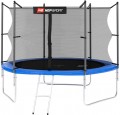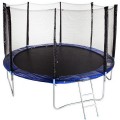Net
The type of safety net provided in the design of the trampoline.
For details on the grids themselves, see "Packaging", and their types can be as follows:
-
External. Mesh stretched over supports from the outside. This design leaves the maximum possible area of the trampoline open, but requires care so that the jumper does not hit the stand or step on the cape covering the springs. Therefore, this option is recommended primarily for adults, more or less experienced users.
-
Internal. Mesh stretched over supports from the inside. With the same dimensions of the trampoline, it leaves less free space than the outer one. At the same time, the net supports and the springs of the trampoline itself remain behind the fence, and the risk of an unpleasant collision with them is minimal. Therefore, for children, especially small ones, it is internal nets that are recommended.
Trampoline size (LxWxH)
The overall size of the trampoline; in this case, the height can be measured both by the height of the working surface, without taking into account the protective grid and other additional devices, and by the overall dimensions of the product in the working position. Also note that the size of the working area on the canvas is usually less than the overall dimensions in length and width — there is protection along the edges that covers the springs, and it is undesirable to jump on it.
Mesh height
The height of the regular trampoline protective net (see "Complete set"). This height is usually measured from the working surface, which allows you to evaluate the protective properties of the mesh. The higher it is, the better, but in general it is desirable that the height is not lower than the height of the intended user (or at least slightly lower).

